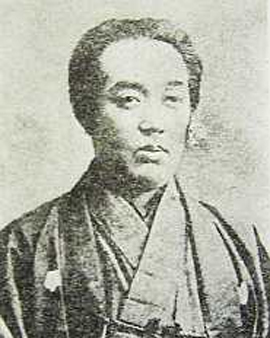The life and work of Tsukioka Yoshitoshi was profoundly shaped by a collision of two cultures that could not have been more different. Born into the world of feudal Japan, Yoshitoshi grew up in the civil wars of the crumbling Japanese shogun empire. A world characterized by warlords, violence, and the code of honor of the samurai, Japan's warrior caste. Japanese culture was characterized by centuries of self-imposed isolation from its environment. Into this secluded world, Western culture burst in 1853 in the form of U.S. gunboats that forced an economic opening. The Western culture of the 19th century had a shocking effect on the technically and militarily hopelessly inferior Japanese. Yoshitoshi initially showed great interest in Western culture. However, the culture shock led the artist in the end to a return to traditional Japanese forms of art and expression.
Yoshitoshi grew up in the samurai culture and at the age of 11 became an apprentice to Utagawa Kunivoshi, a master of traditional Japanese woodblock art. This Japanese art form came under pressure from the new mass production of images in the form of lithography and photography with the economic and technical opening to the West. Yoshitoshi's woodblock prints were popular in Japan towards the end of the 19th century, and he also succeeded in publishing them in newspapers and magazines that were based on Western models. However, his art form slowly disappeared from the cultural context. With the emergence of modern Japan, Yoshitoshi and his art disappeared from public memory and was rediscovered only in the 1970s. Today, Yoshitoshi is considered the last representative of Japanese woodblock art.
Yoshitoshi's popularity in Meiji period Japan is partly a protest against the tendencies of Westernization in Imperial Japan, and partly lies in his repertoire. His early works in particular were characterized by extreme depictions of death and violence. They thus corresponded to the life experience of most Japanese in the civil wars of that era. Excessive violence and lawlessness were the order of the day. The clash of civilizations left a feeling of uprootedness and chaos. All of this can be found in Yoshitoshi's cuts.
×





 - (MeisterDrucke-20200).jpg)
 - (MeisterDrucke-20200).jpg)
 - (MeisterDrucke-637413).jpg)
 - (MeisterDrucke-637413).jpg)
 - (MeisterDrucke-102317).jpg)
 - (MeisterDrucke-102317).jpg)
.jpg)
.jpg)
.jpg)
.jpg)
.jpg)
.jpg)
.jpg)
.jpg)
.jpg)
.jpg)
.jpg)
.jpg)
 - (MeisterDrucke-641608).jpg)
 - (MeisterDrucke-641608).jpg)
.jpg)
.jpg)
.jpg)
.jpg)
_-_(MeisterDrucke-1366627).jpg)
_-_(MeisterDrucke-1366627).jpg)
.jpg)
.jpg)
.jpg)
.jpg)
 - (MeisterDrucke-198766).jpg)
 - (MeisterDrucke-198766).jpg)
.jpg)
.jpg)
.jpg)
.jpg)
.jpg)
.jpg)
.jpg)
.jpg)
.jpg)
.jpg)
.jpg)
.jpg)
.jpg)
.jpg)
.jpg)
.jpg)
.jpg)
.jpg)
.jpg)
.jpg)
Honderd_aspecten_van_de_maan_(series_t_-_(MeisterDrucke-1364827).jpg)
Honderd_aspecten_van_de_maan_(series_t_-_(MeisterDrucke-1364827).jpg)
Tsuki_hyakus_-_(MeisterDrucke-1365516).jpg)
Tsuki_hyakus_-_(MeisterDrucke-1365516).jpg)
.jpg)
.jpg)
Honderd_aspecten_van_d_-_(MeisterDrucke-1366663).jpg)
Honderd_aspecten_van_d_-_(MeisterDrucke-1366663).jpg)
.jpg)
.jpg)
Honderd_aspecten_v_-_(MeisterDrucke-1363711).jpg)
Honderd_aspecten_v_-_(MeisterDrucke-1363711).jpg)
Honderd_krijge_-_(MeisterDrucke-1362538).jpg)
Honderd_krijge_-_(MeisterDrucke-1362538).jpg)
.jpg)
.jpg)
_-_(MeisterDrucke-1613344).jpg)
_-_(MeisterDrucke-1613344).jpg)
.jpg)
.jpg)
.jpg)
.jpg)
Honderd_aspecten_van_de_ma_-_(MeisterDrucke-1362653).jpg)
Honderd_aspecten_van_de_ma_-_(MeisterDrucke-1362653).jpg)
.jpg)
.jpg)
.jpg)
.jpg)
.jpg)
.jpg)
.jpg)
.jpg)
Yoshitoshi_man_-_(MeisterDrucke-1364470).jpg)
Yoshitoshi_man_-_(MeisterDrucke-1364470).jpg)
Tsuki_hyak_-_(MeisterDrucke-1374709).jpg)
Tsuki_hyak_-_(MeisterDrucke-1374709).jpg)
Honderd_aspecten_van_de_maan_(series_title)Tsuki_hyaku_-_(MeisterDrucke-1364023).jpg)
Honderd_aspecten_van_de_maan_(series_title)Tsuki_hyaku_-_(MeisterDrucke-1364023).jpg)
_-_(MeisterDrucke-1374423).jpg)
_-_(MeisterDrucke-1374423).jpg)
.jpg)
.jpg)
.jpg)
.jpg)
.jpg)
.jpg)
.jpg)
.jpg)
.jpg)
.jpg)
.jpg)
.jpg)
 - (MeisterDrucke-179526).jpg)
 - (MeisterDrucke-179526).jpg)
Honderd_as_-_(MeisterDrucke-1361877).jpg)
Honderd_as_-_(MeisterDrucke-1361877).jpg)
.jpg)
.jpg)
.jpg)
.jpg)
.jpg)
.jpg)
.jpg)
.jpg)
.jpg)
.jpg)
Honderd_spookverhalen_u_-_(MeisterDrucke-1363519).jpg)
Honderd_spookverhalen_u_-_(MeisterDrucke-1363519).jpg)
.jpg)
.jpg)
_from_the_serie_-_(MeisterDrucke-1278740).jpg)
_from_the_serie_-_(MeisterDrucke-1278740).jpg)
.jpg)
.jpg)
.jpg)
.jpg)
_-_from_the_series_One_hundred_asp_-_(MeisterDrucke-875248).jpg)
_-_from_the_series_One_hundred_asp_-_(MeisterDrucke-875248).jpg)
.jpg)
.jpg)
.jpg)
.jpg)
_-_(MeisterDrucke-1364479).jpg)
_-_(MeisterDrucke-1364479).jpg)
.jpg)
.jpg)
.jpg)
.jpg)
_-_(MeisterDrucke-1640105).jpg)
_-_(MeisterDrucke-1640105).jpg)
.jpg)
.jpg)
_-_(MeisterDrucke-1383217).jpg)
_-_(MeisterDrucke-1383217).jpg)
_from_the_series_One_Hundred_Aspe_-_(MeisterDrucke-1290925).jpg)
_from_the_series_One_Hundred_Aspe_-_(MeisterDrucke-1290925).jpg)
_-_(MeisterDrucke-1455012).jpg)
_-_(MeisterDrucke-1455012).jpg)
.jpg)
.jpg)
.jpg)
.jpg)
.jpg)
.jpg)
.jpg)
.jpg)
.jpg)
.jpg)
.jpg)
.jpg)
.jpg)
.jpg)
.jpg)
.jpg)
.jpg)
.jpg)
Honderd_krijgers_geselecteerd_door_Yoshitoshi_(ser_-_(MeisterDrucke-1365593).jpg)
Honderd_krijgers_geselecteerd_door_Yoshitoshi_(ser_-_(MeisterDrucke-1365593).jpg)
.jpg)
.jpg)
.jpg)
.jpg)
Honderd_aspecte_-_(MeisterDrucke-1366832).jpg)
Honderd_aspecte_-_(MeisterDrucke-1366832).jpg)
.jpg)
.jpg)
.jpg)
.jpg)
.jpg)
.jpg)
.jpg)
.jpg)
.jpg)
.jpg)
.jpg)
.jpg)
.jpg)
.jpg)
.jpg)
.jpg)
Yoshitoshis_sel_-_(MeisterDrucke-1361749).jpg)
Yoshitoshis_sel_-_(MeisterDrucke-1361749).jpg)
.jpg)
.jpg)
.jpg)
.jpg)
_Co_-_(MeisterDrucke-941503).jpg)
_Co_-_(MeisterDrucke-941503).jpg)






